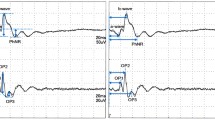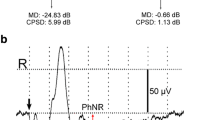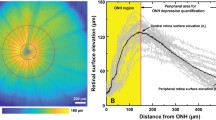Summary
EOGs were obtained from 2 groups of patients suffering from glaucoma chronicum simplex the day before surgery and 3, 5, 8, 11 and 14 days after trephining or fistulizing operation after Scheie. Though and peak potentials of the treated eyes were significantly less than those of the untreated fellow eyes five days after surgery. In addition on the 11. postoperative day after Scheie a second potential decrease was seen. The EOG-changes observed appear to reflect disturbances of the choroidal circulation after fistulizing operations.
Zusammenfassung
An 2 Gruppen von Patienten mit beidseitigem Glaucoma chronicum simplex wurde das EOG am Tage vor der Operation und am 3. 5. 8. 11. und 14. Tag nach Elliot'scher Trepanation bzw. nach Scheie abgeleitet. Am 3.–5. postoperativen Tag nach einem Elliot zeigen sowohl der Dunkelwert als auch der Hellwert eine statistisch signifikante Potentialabnahme, die sich bis zum 14. postoperativen Tag wieder erholt. Noch stärker ist die Potentialabnahme nach einem Scheie. Hierbei läßt sich auch ein 2. Potentialabfall am 11. postoperativen Tag registrieren. Die hier beobachteten EOG-Veränderungen werden auf die Kreislaufstörung der Aderhaut nach fistulierenden Operationen zurückgeführt.
Similar content being viewed by others
Literatur
Alexandridis, E.: Veränderungen des Bestandspotentials des Auges (EOG) bei Aderhautabhebung. Klin. Mbl. Augenheilk.157, 395–399 (1970)
Arden, G. B., Barrada, A., Kelsey, J. H.: New clinical test of retinal function based upon the standing potential of the eye. Brit. J. Ophthal.46, 449–467 (1962).
Cole, D. F.: Electrochemical changes associated with the formation of the aqueous tumor. Brit. J. Ophthal.45, 202–217 (1961)
Duke-Elder, S.: The physiology of the intraocular fluids and its clinical significance. Amer. J. Ophthal.32, 1638–1644 (1949)
Duke-Elder, P. M., Duke-Elder, S.: The vascular response of the eye. Proc. roy. Soc. (Lond.)109, 19–28 (1931)
Greef, R.: Befund am Corpus eiliare nach Punktion der vorderen Kammer. Arch. Augenheilk.38, 178–192 (1894)
Heck, J., Papst, W.: Über den Ursprung des corneo-retinalen Ruhepotentials. Bibl. ophthal. (Basel)48, 96–107 (1957)
Kelsey, J. H.: The combined use of the EOG and ERG as a routine clinical procedure. 6th ISCERG-Symp, p. 19–28. Leipzig: Thieme 1968
Kohlrausch, A.: Elektrische Erscheinungen des Auges. In: Handbuch der normalen und pathologischen Physiologie, Bd. XII, S. 1393–1496. Berlin: Springer 1931
Lehmann, G., Meesmann, A.: Über das Bestehen eines Donnangleichgewichts zwischen Blut und Kammerwasser bxw. Liquor cerebrospinalis. Pflügers Arch. ges. Physiol.205 210–232 (1924)
Meier-Ruge, W.: The pathophysiological morphology ot the pigment epithelium and its importance for retinal structures and functions. Probl. Ophthal.8, 32–48 (1969).
Perkins, E. S.: Influence of the fift cranial nerve on the intra-ocular pressure of the rabbit eye. Brit. J. Ophthal.41, 257–300 (1957)
Poos, F.: Über die histologischen und klinischen Erscheinungen bei akuten, lokalen Capillarkreislaufstörungen am Auge. Albrecht v. Graefes Arch. Ophthal.127, 489–574 (1931)
Poos, F.: Gefäßreaktion und Augendruck. Klin. Mbl. Augenheilk.100, 606 (1938).
Purtscher, E.: Histologische Frühuntersuchungen nach intracapsulärer Staroperation. Albrecht v. Graefes Arch. Ophthal.144, 669–697 (1942).
Rohen, J.: Morphologische Beiträge zum Problem der Kammerwasserbildung. I. Die Gestalt der Blutkammerwasserschranke beim Kaninchen in Ruhe und nach funktioneller Belastung. Ber. dtsch. ophthal. Ges.58, 65–70 (1953)
Roth, H. J., Alexandridis, E., Pape, R.: The electro-oculogramm in the early postoperative period following intracapsular cataract surgery. Albrecht v. Graefes Arch. klin. exp. Ophthal.190, 207–214 (1974)
Samojloff, A. J.: Die Reaktion des Menschenauges auf die Kammerpunktion. Albrecht v. Graefes Arch. Ophthal.122, 139–145 (1929)
Wessely, K.: Bemerkungen zu einigen Streitfragen aus der Lehre vom intraokularen Flüssigkeitswechsel. Arch. Augenheilk.88, 217–252 (1921)
Author information
Authors and Affiliations
Rights and permissions
About this article
Cite this article
Alexandridis, E., Appel, C. & Lampert, J. Das Elektrooculogramm im Frühverlauf nach fistulierenden Operationen bei Glaucoma chronicum simplex. Albrecht v Graefes Arch. klin. exp. Ophthal. 195, 49–55 (1975). https://doi.org/10.1007/BF02390030
Received:
Issue Date:
DOI: https://doi.org/10.1007/BF02390030




